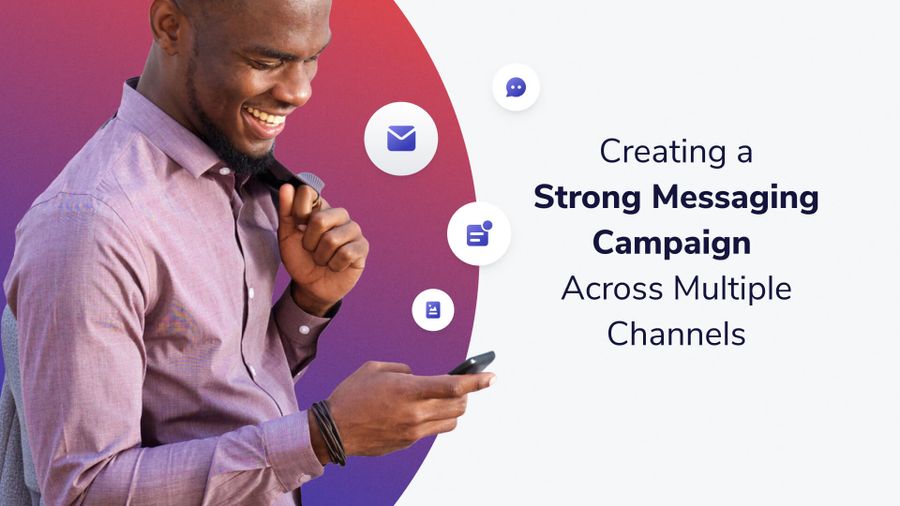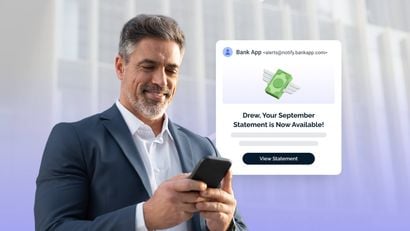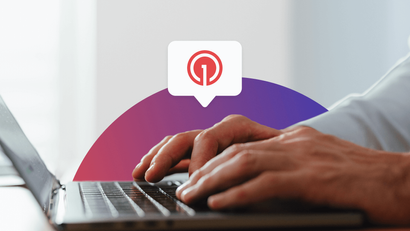What is a Cross-Channel Messaging Campaign?
Cross-channel messaging, as you might guess, involves communicating to your customers in a coordinated way across more than one channel.
A cross-channel messaging approach is strategic in that it delivers your brand’s content in the format and at the time you deem most useful for your audience.
In today’s market, your brand should aim to establish its presence in as many channels as possible, given the sheer number of brand communications your audience is already receiving on a daily basis.
Launching a cross-channel strategy is a more powerful way to cater to your audience on multiple platforms based on their unique activity. Sending complementary messages across channels can be more tactical than blasting your users with a flurry unwanted messages in a single channel. Excessive or poorly timed messages can run the risk of annoying your users or turning them off of your brand.
Take the following as an example of a cross-channel flow.. After a user downloads your app, you can send them a subsequent onboarding email series showcasing your gaming app’s key features. After they’ve engaged with these communications, you can then retarget them with a push campaign encouraging them to complete key milestones in your game.
Cross-channel messaging can be a more profitable approach in the long run compared to using a single channel as your primary messaging medium. Cross-channel marketing is a smarter, more cost-effective way to leverage each channel within your messaging strategy.
It’s also a better way to nurture leads, provide an optimal customer experience, and implement personalization to better users’ relationship with your brand.
Why OneSignal is a Powerful Marketing Tool
Today, we’re a market-leading customer messaging and engagement solution, offering mobile and web push notifications, in-app messaging, SMS, and email. Our powerful multi-channel platform enables one million businesses to deliver over 10 billion messages daily. Powered by superior architecture, OneSignal is designed to scale with your business and deliver messages more quickly and reliably than the competition.
When to Utilize Cross Channel Messaging Workflows
Align the tone, type, and frequency of a message with the stage and context your users find themselves in. This will in turn bring them closer to the conversion you wish for. That said, you’ll want to play the long game and message users sparingly and strategically in each channel to retain them more successfully.
Choosing the Right Medium Within a Cross-Channel Messaging Approach
With a cross-channel approach, you can align your messaging goals with the best use cases for each of the most effective user communication channels. Here are some ideas around the the best ways to use each of these channels for the appropriate use cases, and how each channel is different from the others you may already be using.
Mobile Push Notifications
Mobile push let you distribute content to mobile users even when they’re not using your app or visiting your website.
Unlike a channel such as SMS, push notifications don’t require that you collect a user’s phone number or contact information, but they do require that you earn opt-in permission. Both SMS and push notifications have character limitations, but may include other types of content such as images, gifs, brand logos, and more nuanced CTAs.
Mobile push notifications are ideal for both transactional and marketing messages because they appear front and center on a user’s phone. Due to their placement, they receive high visibility with your mobile first audiences. As part of your news app’s cross channel strategy, for example, you might choose to send breaking news alerts via push, but reserve more comprehensive news roundups for an email sequence that you send once a week.
Email is a legacy channel ideal for distributing long-form content. This medium is beneficial for account-related emails like password resets, account confirmations, and security alerts. Email can have a place in your cross-channel strategy for sending longer form, official communications, company resources, and gated assets. Unlike push and SMS, this channel is not real-time and is more crowded than your other complementary channels.
As part of your food delivery app’s flow, you might use email to send itemized order receipts after a user has placed an order within your platform. You can send push as part this cross-channel strategy by sending real-time delivery updates as users’ orders are placed, prepped, and delivered.
Using Cross-Channel Retargeting to Increase Engagement Based on User Actions
With an effective cross-channel retargeting feature, send users a follow-up text after users have engaged with a push notification, or send subscribers a push to reinforce an SMS. Retarget push notifications with another push, SMS messages with an email, or retarget users across your push, email, and SMS audiences. With retargeting, you can create a follow-up message audience based on user actions.
SMS
SMS, or Short Message Service, is a channel that involves sending text messages directly to the user. SMS requires that users opt in via a different channel in order to to adhere to compliance standards issued by the Telephone Consumer Protection Act (TCPA).
In contrast to legacy communication channels such as email, SMS boasts higher open rates and typically elicits a quicker response, making it a powerful platform when used correctly. In fact, 82 percent of people say they open every text message that they receive.
5 Tips to Build a Successful Cross-Channel Messaging Campaign
1. Start With a Measurable Plan
Knowing how your customers engage with your messaging is key to optimizing your follow-up strategy. What this means is evaluating your users’ reactions to your messaging at every touchpoint, which can then inform the type, tone, and channel of the next message in your campaign.
Benchmarking performance metrics should be at the core of your process in order to understand the success of your campaigns.
2. Set Meaningful Goals
Alongside evaluating performance, you’ll want to establish goals around the engagement, conversion, and retention benchmarks that you’ve deemed important within your strategy.
Before you design and execute your cross-channel sequences, you should define exactly what the series aims to do. What action do you want your users to complete at the end of this process?
3. Personalize Communication
Studies have shown that personalization is a powerful factor in your audience’s receptiveness to your messages.
To better personalize your messages, leverage the user data you have in order to understand the best types of messages to send across channels. One way you can effectively personalize the user experience is through journeys, which helps you adapt to your users’ behavior.
4. Tailor Your Messaging to Each Channel & Customer Journey
With a well-mapped and executed journey, you can achieve seamless cross-channel orchestration. Engage with audiences and deliver automated, personalized and relevant experiences across messaging channels.
Here are some examples of how our clients have build out customer journeys using the key features we’ve described..
Examples include the following:
Upside Health, a pain management healthcare app, harnesses Journeys to launch a multi-week engagement sequence around their wellness events using tags and customer segments created in Mixpanel.
CeleBreak, an app for finding and joining local soccer games, utilizes Journeys to automate sending notifications to encourage users to join upcoming games they have viewed.
FishVerify, a sport fishing app, uses Journeys to power automated, customized onboarding sequences based on a customer's engagement, as well as to trigger new offers following the onboarding journey.
5. Automate Your Notification Sequence
With automation, you can trigger messages based on user actions and behavior, so you can personalize the content to your users’ experiences. Personalization increases your relevancy, which leads to higher open rates and customer engagement.
Get Started with OneSignal
OneSignal is designed to help you seamlessly manage your user communication across a variety of channels. Our platform is quick to set up and makes it easy to send eye-catching emails, push notifications, in-app messages, and bulk SMS without doing any development work. With our Journeys builder tool, you can automate and trigger push notifications and emails based on user behavior, all from a single campaign.
If you don't have a OneSignal account, you can create one for free and start sending automated cross-channel campaigns today. Don't take our word for it — simply sign up and see for yourself!
Create a Free Account



